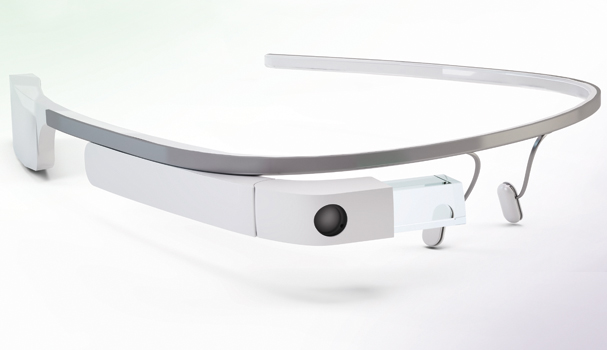You know when you’re trying to find your next meeting while staring at a map on your phone and struggling with a laptop case? Google Glass aims to fix that problem and a fair few more.
It’s the ultimate piece of wearable tech, turning your shades into a web portal. It can provide a real-time stream of the latest information that doesn’t need to waste time going via your fingertips. Google’s typically understated mission is to produce the mass market ubiquitous computer.
On the side of your Google Glass is a touchpad letting you control things by swiping through a timeline-esque display. Sliding backward shows current events, such as weather, and sliding forward shows past events, such as phone calls, photos and the like. Most controversially there’s a camera: Glass can take photos and record 720p HD video. This has given rise to major concerns over privacy.
The information comes in your eyeline so you can see it without having to look down. You interact with the device by speaking – saying “OK Glass” and then an instruction like “take a photo” or “direct me to my next meeting”.
There are an increasing number of apps available for Glass including many existing Google applications such as Google Now, Google Maps, Google+ and Gmail. Additional apps include Evernote, OpenTable, and Strava, with others including facial recognition, photo manipulation and translation.
The Glass also now comes in various styles with Google having teamed up with Luxottica, which produces Ray Ban and Oakley glasses.
How can it be used?
So far, the fuss around Glass has been focused on the privacy issues and the social norms about its use in public. It’s annoying enough when your lunch companion checks their phone but imagine when you suspect them of browsing the web mid-conversation.
Indeed the furore has spawned a new term for those that wear the technology: the ‘Glasshole’. But it’s outside of personal use where the most interesting applications of Google Glass are being seen.
Glass has the potential to revolutionise training and the sharing of knowledge. Recently, a team of doctors led by US-based orthopaedic surgeon Selen G. Parekh performed a foot surgery at an Indo-US conference in Jaipur, using the technology to broadcast the procedure live over the web. Dr. Ashish Sharma, who organised the conference, said that he can see a time when the device could be employed to communicate with patients’ families, help teach students remotely and collaborate with other doctors during a surgery.
The construction industry is also exploring the use of the platform. Companies like FieldLens and Procore are releasing Glass apps, aiming to let workers access plans, safety documents and even machine or tool instructions without having to drop what they’re doing. You could even pull up an instructional video if you are a trainee builder. Imagine having hands-free browsing when you’re working on top of a skyscraper.
Manufacturers could also benefit from on-the-job instruction – GM North America is exploring its use, seeing immediate benefits for quality control processes and for training staff. As with medicine, the in-built camera can be used to live stream what the operator sees and to record for future documentation.
Even more traditional industries like farming have seen a role for Glass. A developer called Basecamp Networks has created the IntelliScout application to make it easier for farmers to spot and log issues with crops (eg pests), without having to pull out their camera or smartphone. They can record what they see, as they see it, and instantly send it to others while in the field.
Not everybody is a fan though. Despite being a fairly sci-fi piece of kit, NASA has said it’s not much use in space. “Google Glass is a promising technology but needs to overcome battery life, display viewing and scrolling issues in order to be an operational useful tool,” it reportedly declared.
But what about my company?
It’s one thing for international doctors, General Motors, or NASA to use (or not use) Google Glass but what about us mere mortals? How and where could we use a Glass in our companies?
The technology works best when you need to get information but typing is difficult (remember the builder on top of the roof?). After all, if you can easily type, why not just use a smartphone or tablet? There’s none of the social awkwardness.
Think about any kind of skill-heavy maintenance work, such as fixing cars or particular appliances or machinery when on site, or working with unfamiliar or old equipment. It would also work well for some kinds of customer service – airports, event co-ordination, hotels, and high-end office receptions.
It’s also great if anything you are doing needs to be recorded: we’ve already seen the training potential. Maybe you could record your star sales person as they handle a meeting or your warehouse team, in order to make sure your storage facility is as efficiently organised as possible.
It would also be a fantastic sports training aid – you could record your team’s training up close and personal, getting a real feel for how to best improve their technique. Imagine refereeing with the ability to see instant video playback on contentious decisions – it may at least save a few Sunday afternoon squabbles.
The opportunity
Love it or hate it, the Glass – and other wearable tech platforms – are the thin edge of a very large wedge of technology and will be a feature of our lives for the foreseeable future.
Those who can embrace these platforms – making the most of their practical applications while avoiding the pitfalls – will gain real advantages. And someone needs to build these apps, creating opportunites for companies like mine. We are already exploring Glass apps in our R&D activity and for numerous new tech startups.
So why not put on your “tech specs” and get ready to see the future? ![]()
Share via:








































